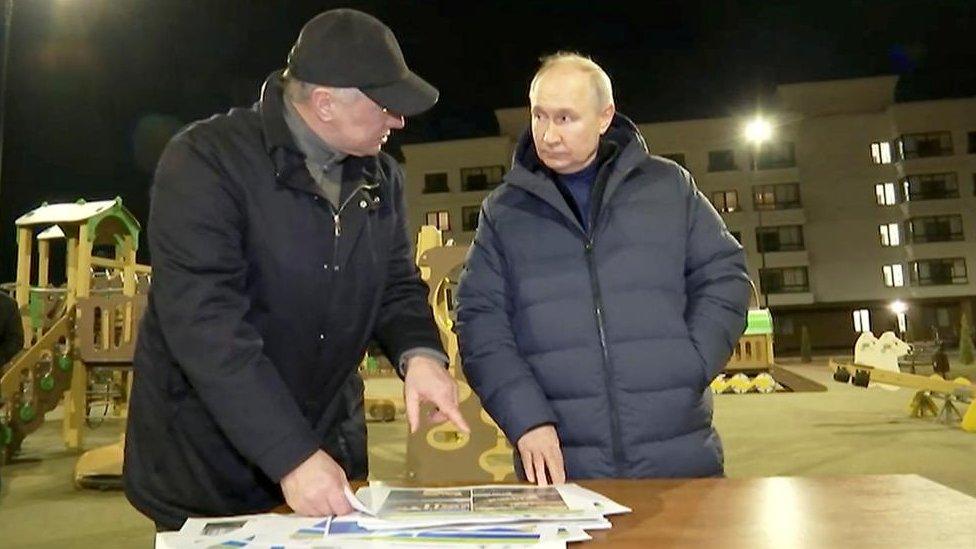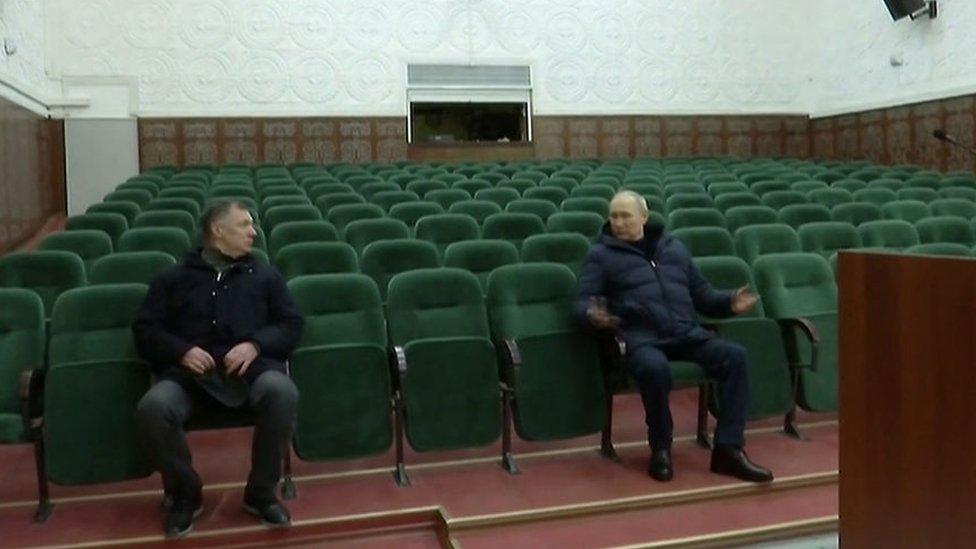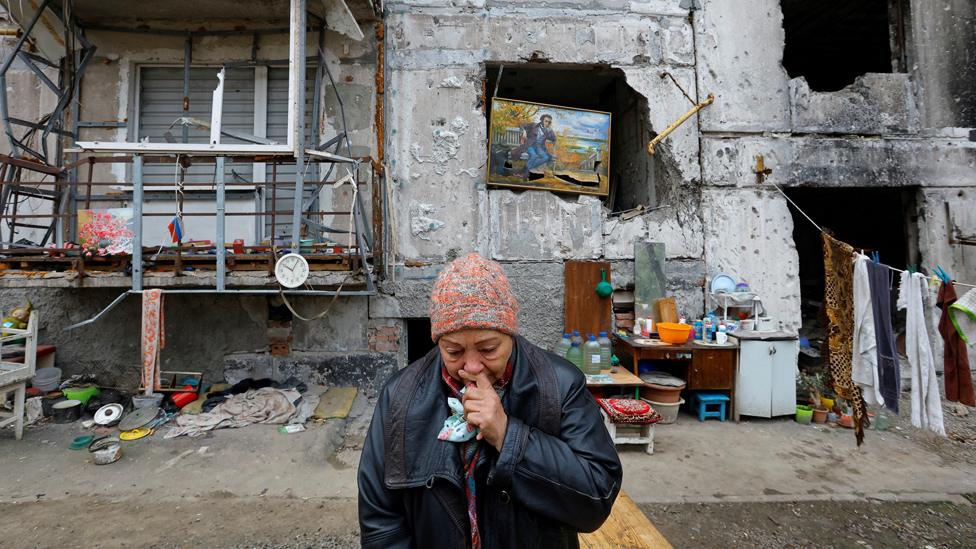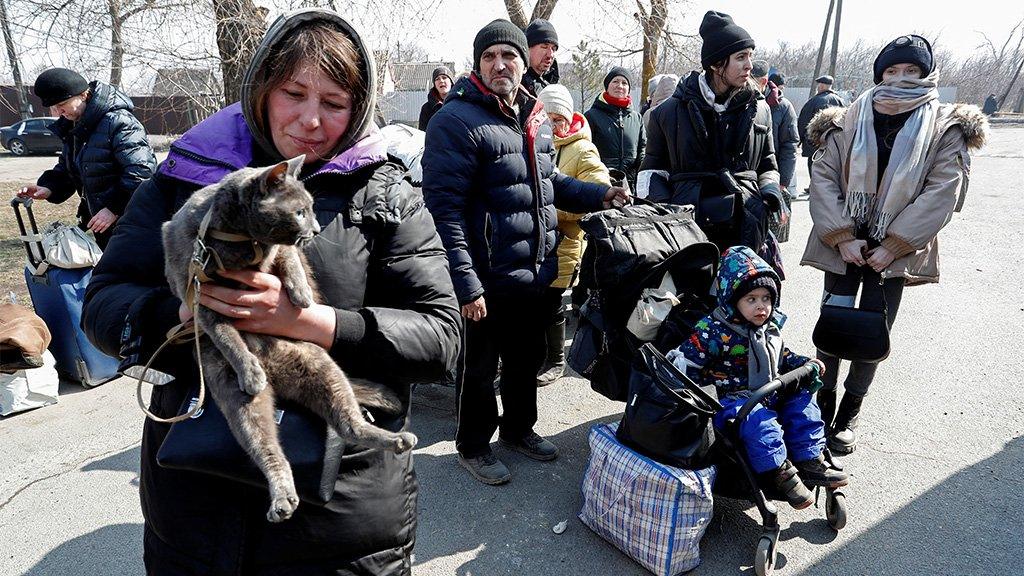Putin in Mariupol: What the Russian president saw on his visit
- Published
Watch: Russia's President Putin tours Mariupol in occupied Ukraine
Driving through the ruined city at night, Vladimir Putin has made his first visit to Mariupol - devastated when Russian forces besieged the city earlier on in the war.
The BBC has traced part of the route he took, which passed near the locations of several notorious attacks during his army's months-long assault. Russia finally overran the city in May.
Video released by Russian media show Mr Putin chatting to a companion as they head towards the city's concert hall. The Kremlin says the visit took place late on Saturday and Mr Putin decided "spontaneously" to tour the city.
Mariupol's Ukrainian mayor in exile Vadym Boychenko told the BBC that Mariupol was "personal" to Mr Putin because of what had happened there.
"We have to understand that Mariupol is a symbolic place for Putin, because of the fury he inflicted on the city of Mariupol. No other city was destroyed like that. No other city was under siege for so long. No other city was subjected to carpet bombing," he said.
"He has come in person to see what he has done," he added.
Driving past the scene of Russian attacks
The BBC identified some of the key landmarks along the Russian leader's route. Mr Putin appears to be driving down Kuprina St, turning into Myru Avenue and then into Metalurhiv Avenue, where the Philharmonic Concert Hall is and which he visits later on in the footage.
He is sitting next to a man in a black cap, who Russian media identify as Russian Deputy Prime Minister Marat Khusnullin.
On his left as they drive down Myru Avenue are sculptures of birds in what was Mariupol's Freedom Square.
Further on, on the right and not shown in the footage, is Mariupol's Maternity Hospital Number Three, which was bombed in a notorious incident last March.

Pictures of heavily-pregnant Marianna Vyshemirskaya, her face bloodied, descending rubble-strewn steps were widely shared amid outrage at the attack. She survived and gave birth the following day. Another pregnant woman was among the victims.
Ukrainian President Volodymyr Zelensky called it a war crime but Russia's embassy in London claimed the hospital had no longer been in use, and was instead being used by members of the Azov regiment, which was set up as a volunteer militia with links to the far right in 2014 but had since been incorporated into Ukraine's National Guard.
Mr Putin turned off Myru Avenue just before the road arrives at Theatre Square - the scene of a deadly bombing that is thought to have killed at least 300 and possibly as many as 600 civilians.
Civilians had been using the building as a refuge from the siege and a large sign spelling "children" had been daubed in Russian in front of the theatre. The building collapsed when it was hit. Russia denied bombing it and blamed the Azov battalion. In December the Ukrainian city authorities in exile said Russia was demolishing the ruins of the theatre.
Russia "understood where there was a concentration of people, and deliberately destroyed these places, killing people. They systematically worked on this", said Mr Boychenko.
Visits new Russia-built compound in outer Mariupol
Footage then shows Mr Putin on a walking tour of a new residential compound, said to be in Mariupol's Nevsky district. He is guided by Mr Khusnullin, who shows him some plans of the reconstruction work. He is also seen talking to people said by Russian media to be local residents and he also visits an apartment that he is told is made up of three rooms.
Nevsky is a new district comprising a dozen apartment blocks in the west of the city. It is named after the River Neva, on which President Vladimir Putin's home city of St Petersburg stands.
Mayor Boychenko said many of the Russian-built buildings were on the city outskirts. "They built this just to prove that their version of what's happening there is true. But they lie! They lie that they came to liberate the city. But they destroyed it. This city does not exist any longer. And it takes 20 years to restore it!" he said.

Mariupol residents have been telling the BBC that new buildings are going up and some of those damaged by the Russian military are being removed. The UN estimates that 90% of residential buildings were damaged or destroyed in the Russian onslaught.
Norwegian journalist Morten Risberg, who visited Mariupol in December, said he saw "large-scale rebuilding and restoration" amid "destruction everywhere you looked".
"They're changing street names and they're painting over Ukrainian colours with Russian colours, and they're putting Russian flags everywhere," he told the BBC. Most of the remaining civilians in the city were "just focusing on surviving", he said.
Walking through Mariupol's Philharmonic concert hall
In another part of the footage, President Putin is seen walking through the interior of a concert hall in Mariupol. Russian state media said it was the Philharmonic Concert Hall - and the BBC has verified that the footage matches the interior of the venue.
This is the same building that the UN warned was to be used to stage trials of Ukrainian troops who held out against Russian forces for months in Mariupol's massive Azovstal iron and steel plant. Russia finally gained complete control of Mariupol in May after the defenders surrendered.

The concert hall was to be the venue for show trials of Ukrainian POWs but they were traded in a prisoner swap instead
Images posted on social media in August - including by Ukrainian authorities - appeared to show metal cages being built on the stage. According to the UN, prosecuting prisoners of war (POWs) for taking part in hostilities is a war crime.
But the trials never took place, as the POWs were later part of a prisoner swap for 55 prisoners from Ukraine, including a pro-Kremlin former MP, Viktor Medvedchuk.
The latest footage from inside the concert hall shows the interior of the building has since been redecorated and the cages are no longer visible.
During the siege the concert hall, like the drama theatre, was used by civilians for shelter. The cultural institutions were "where people hid in basements and waited for the Russian terror to end," Mr Boychenko said.
Before the invasion it had been the venue for the Mariupol Classic festival for classical music. Mr Boychenko said the festival was a "great celebration of classical music for the people of Mariupol" that drew artists from abroad and other parts of Ukraine.
"Many people always gathered at this festival to feel the mood that always prevailed in Mariupol," he said.
In a later shot, President Putin is seen visiting a World War Two memorial built to commemorate Soviet troops who recaptured the city from Nazi Germany.
Additional reporting by the BBC's Osint reporter Benedict Garman
Related topics
- Published13 March 2023

- Published17 May 2022

- Published17 May 2022
